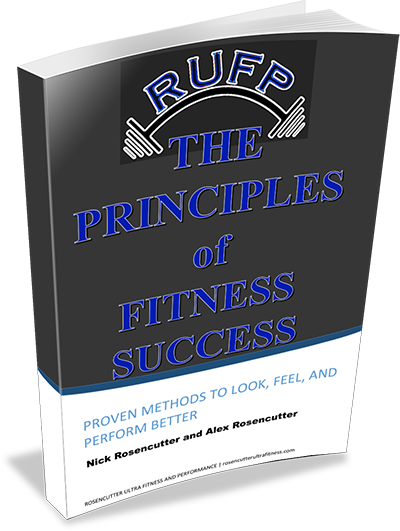
By Nick Rosencutter
Upper body training. Probably the most popular emphasis of training that you will see if you walk through most gyms throughout the country. Everybody loves pumping their biceps and building their chests up. If you are lucky, you might even find someone who enjoys chiseling out their upper back. While working the upper body might be a very common thing to come across, very few people actually understand how to train it correctly. This is because very few people understand the anatomy and biomechanics of the activities that occur up top. (and if these things were understood even a little bit, those lovely things below the belt called legs would never be neglected).
So, when we look at gym goers who do hit their upper halves a few times a week, we can generally put people into a few different groups.
Group 1- The Bench and Curl All Day Every Day Group. These people love working the muscles that they see in the mirror and do many variations of pressing and curls with some extra delt and tricep work thrown in for good measure here and there. Neglecting the opposing muscles in the back leads to problems down the road and they are left with imbalances and shoulder issues.
Group 2- The Train with some Push-Pull Balance Group. These people at least understand the importance of balancing out pushing and pulling exercises and try to do some kind of pulling exercise to provide some balance to whatever pushing/pressing exercise they might be doing.
Group 3- The Shoulder Mechanics Involve More than 2 Motions Group. These are those in the know that understand the anatomy and mechanics of the shoulder and train movement and muscle around their upper bodies with some decent anatomically balanced precision; often leading to less shoulder issues and better looking and better performing postures.
Digging into this a little deeper, while group 1 is way off of the map, group 2 at least has SOME realization about balancing out the anatomy. So what is it that they are missing that Group 3 is not? That my friends, is the question that we shall answer with the rest of this article.
To understand how to properly train, we must first look at the anatomy and mechanics. I’m going to keep this straight forward and basic so this doesn’t turn into a textbook lesson. The first thing we need to look at is the scapula (known as your shoulder blade in street talk) and the motions it is capable of. The scapula lays on the back of your rib cage and has connections with your clavicle (collar bone) and humerus (arm bone). When we talk about “push pull balance,” we are generally talking about protraction and retraction of the scapulae (although many people don’t get quality protraction even with their pushing), flexion/extension, and on some occasions, internal/external rotation of the glenohumeral joint (what most think of as the shoulder joint) .
While having some balance here is great, we also need to factor in the multiple other possible actions of the scap and gh joint. The scap can also elevate, depress, rotate upward, rotate downward and tilt forward and backward. The gh joint also internally and externally rotates, adducts and abducts. There are certain muscles that help to perform all of these actions. Anytime we move our arm, whether that be forward and backward, out to our sides or overhead and back down, our scapula, gh joint and our thoracic spine all need to move with a certain harmony amongst each other. When one of these is off, the other(s) must compensate in order to create further motion. Most commonly, the scapula stops moving or moves abnormally and the humeral head (top of the arm bone) glides either upward or forward to compensate, leading to impingement. Simply pushing and pulling neglects many of these actions, although if we are talking pushing and pulling both horizontally and vertically we are at least getting closer to the prize.
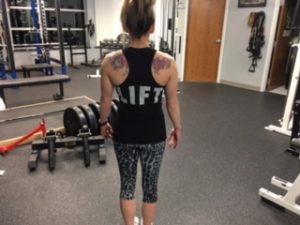
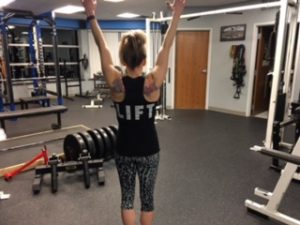
Moving overhead involves multiple pieces, including flexion of the glenohumeral joint, upward rotation of the scapulae and extension of the thoracic spine

Pulling with good protraction of the scapulae and pushing with good protraction of the scapulae
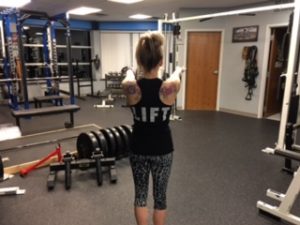
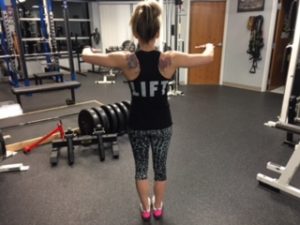
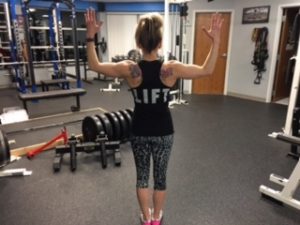
Internal and External Rotation of the shoulder joint (in this instance while the scapulae are in a bit of retraction)
When we look at the most common pushing exercises that are performed, the bench press is definitely towards the top of the list. When we look at pulling exercises, a row variation is towards the top of the list as well. When done correctly, the row will work the rhomboids, mid traps and low traps, the main muscles that pull the scapulae into retraction (they pull your shoulder blades together). When done correctly, the bench press will work your pecs, anterior deltoids and triceps with the actual motion of the press; however, a correct set up involves pulling the shoulder blades together (retraction, as we learned a couple of sentences ago, which also utilizes the rhomboids). When we do too much pressing like this, without any protraction of the scapulae and pair it with straight rowing exercises, we end up getting what we call anterior glide of the humerus, where the top of your humerus (arm bone) moves towards the front of your shoulder joint, creating impingement. This occurs because when the scapulae fails to protract sufficiently during a push motion, the humeral head compensates by moving forward in the shoulder socket excessively (anterior glide); this ends up happening if we never train scapular protraction with our pushing movements. (Similarly, if our scapulae stop upwardly rotating when we move overhead, the humeral head tends to glide UP in the socket, causing impingement at the top of the joint)
To add further complication, when we add in any kind of shrugging exercise which involves elevation of the scapulae, the rhomboids are under pressure even more since they also assist with elevating the scapulae. Throw in some pulldowns or pullups, which involves downward rotation of the scapulae, which also activates the………guess what?………the rhomboids! So while at first glance, you might think that many people would need lots of rowing and pullups to balance out all of their pushing, you can now see that its not so black and white. When you add in the fact that any kind of pressing exercise and any kind of vertical pulling exercise also involve internal rotation of the shoulder joint, we can start to see some patterns occurring. Pecs, lats and deltoids often become overactive, pulling the shoudler joint into internal rotation and, along with the rhomboids becoming overactive, limiting protraction and upward rotation of the scapulae. While many of these people do have overactive rhomboids, many of them do still need to “open up” their shoulders. So how do we do this without creating further complications?
-
We need to balance out the types of pushing exercises we do, being sure to include exercises that allow us to get protraction and/or upward rotation of our scapulae
-
We need to train upward rotation of our scapulae and external rotation of our shoulder joints and/or do this ALONG with retraction.
-
Some people might be excessively depressed and some excessively elevated. This must also be factored into any programming.
-
Balancing out our pushing exercises
Rather than just bench pressing, incline bench pressing, decline bench pressing etc. we need to do some pushing that allows us to move our scaps freely. Landmine presses, cable pushes, overhead presses, and pushups are some great ones. These allow us to get either quality protraction or upward rotation, or some combination of the two. Ensuring that our scapula is able to move effectively in these pathways will better allow our humeral head to stay centered in the glenoid fossa (shoulder socket), preventing impingement and keeping our shoulders healthier.

-
Training our scapulae to upwardly rotate and stimulating the external rotators of our shoulder to help counteract all of the internal rotation going on are essential. Beyond that, we need to train some retraction without the rhomboids taking over. Y variations and basic external rotation variations are great ways to take care of the first two. Face Pull variations are a great way to conquer our third mission here. With a face pull, our scapula is in a position of upward rotation as we pull towards our head. Since rhomboids are also downward rotators of the scapulae, this takes them out of the movement to a certain extent and allows our mid and low traps to do more with the retraction of the exercise. So we have retraction with good recruitment of the mid and low traps in a position of scapular upward rotation, which is great. Add in the fact that we also get some external rotation at the shoulder joint as we pull, and you have a phenomenal exercise that can really do a lot to help balance out all of the issues that we talked about earlier. Both double and single arm variations work well here depending on the situation and person at hand. If there is side to side imbalance going on (one scap is positioned or moves differently than the other) then it is usually best to start with single arm face pulls.

-
If somebody is excessively elevated in their shoulder girdle, it is important to be sure that they do not shrug up as they perform these pulling exercises as this will add to the tension that they most likely feel quite often through their necks and shoulders. Performing a high to low face pull might also be a good idea to encourage some depression of the shoulder girdle as you pull. Being sure to keep the shoulders down and back on most pushing and pulling exercises is important here as well.

If somebody is excessively depressed, we need to get their shoulder girdle back up to a respectable level to allow optimal movement and to provide better support for the neck. These people often feel like their neck is “tight,” since its always being pulled on and stretched with the scapulae sitting lower than they should be. Factoring in the possibility of rhomboids being overactive from our earlier examples, we need to train elevation without overworking them more. Enter the Y shrug. This exercise allows us to engage the upper traps to help pull the scapulae up without adding fire to the rhomboids and levator scapulae, while also encouraging positive upward rotation of the scapulae via the lower traps, upper traps and serratus anterior muscles. Check it out above.
While I could go on all day about more factors that could possibly be considered in our shoulder puzzle and this is by no means an exhaustive list, these tips can and should go a long way in helping you to achieve a better balance around your joint; not to mention they should also help improve your lifts and your physique if those are goals of yours. After all, you can’t have a full road map on your back without hitting all of the muscles that are part of it.
In case you didn’t watch this video earlier, check it out now. We go through a lot of the anatomy considerations mentioned in the article and it should help put some of the things mentioned earlier together for you.

